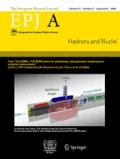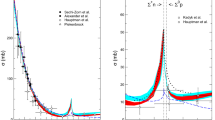Abstract
Three-body forces acting on a \(\varLambda \) hyperon in a nuclear medium are investigated, with special focus on the so-called hyperon puzzle in neutron stars. The hyperon–nucleon two-body interaction deduced from SU(3) chiral effective field theory is employed at next-to-leading order. Hyperon–nucleon three-body forces are approximated using saturation by decuplet baryons and are transcribed to density-dependent effective two-body interactions. These together are taken as input in a Brueckner–Bethe–Goldstone equation with explicit treatment of the \(\varLambda N\leftrightarrow \varSigma N\) and \(\varLambda NN\leftrightarrow \varSigma NN\) coupled channels. Single-particle potentials of a \(\varLambda \) hyperon in symmetric nuclear matter and neutron matter are calculated. With parameters of the \(\varLambda NN\) three-body force constrained by hypernuclear phenomenology, extrapolations to high baryon density are performed. By comparison of the \(\varLambda \) and neutron chemical potentials at densities characteristic of the core of neutron stars it is found that the combined repulsive effects of two- and three-body correlations can make the appearance of \(\varLambda \) hyperons in neutron stars energetically unfavourable, thus potentially offering a possible answer to a longstanding query.








Similar content being viewed by others
Data Availability Statement
This manuscript has no associated data or the data will not be deposited. [Authors’ comment: All data produced in the course of this work have gone into the numerical results presented in Figs. 5-10.]
Notes
We remind that due to direct and exchange contributions to the density-dependent effective YN potentials, these have to be weighted with a statistical factor 1/2 when added to the two-body potentials [37].
References
P. Demorest, T. Pennucci, S. Ransom, M. Roberts, J. Hessels, Nature 467, 1081 (2010)
J. Antoniadis et al., Science 340, 6131 (2013)
E. Fonseca et al., Astrophys. J. 832, 167 (2016)
H.T. Cromartie et al., Nat. Astron. 4, 72 (2019)
B.P. Abbott et al. (LIGO & Virgo Collaborations), Phys. Rev. Lett. 119, 161101 (2017)
E.R. Most, L.R. Weih, L. Rezzolla, J. Schaffner-Bielich, Phys. Rev. Lett. 120, 261103 (2018)
S. De, D. Finstad, J.M. Lattimer, D.A. Brown, E. Berger, C.M. Biwer, Phys. Rev. Lett. 121, 091102 (2018)
A. Akmal, V.R. Pandharipande, D.G. Ravenhall, Phys. Rev. C 58, 1804 (1998)
M. Drews, W. Weise, Phys. Rev. C 91, 035802 (2015)
M. Drews, W. Weise, Prog. Part. Nucl. Phys. 93, 69 (2017)
B. Friman, W. Weise, Phys. Rev. C 100, 065807 (2019)
G. Baym, T. Hatsuda, T. Kojo, P.D. Powell, Y. Song, T. Takatsuka, Rep. Prog. Phys. 81, 056902 (2018)
G. Baym, S. Furusawa, T. Hatsuda, T. Kojo, H. Tagashi, Astrophys. J. 885, 42 (2019)
L. McLerran, S. Reddy, Phys. Rev. Lett. 122, 122701 (2019)
Y. Fujimoto, K. Fukushima, K. Murase, Phys. Rev. D 101, 054016 (2020)
T. Takatsuka et al., Eur. Phys. J. A 13, 213 (2002)
S. Nishizaki, T. Takatsuka, Y. Yamamoto, Prog. Theor. Phys. 108, 703 (2002)
T. Takatsuka, S. Nishizaki, R. Tamagaki, Prog. Theor. Phys. Suppl. 174, 80 (2008)
J.R. Stone, P.A.M. Guichon, H.H. Matevosyan, A.W. Thomas, Nucl. Phys. A 792, 341 (2007)
J.R. Stone, P.A.M. Guichon, A.W. Thomas, arXiv:1012.2912 [nucl-th]
H. Djapo, B.J. Schaefer, J. Wambach, Phys. Rev. C 81, 035803 (2010)
I. Vidaña, D. Logoteta, C. Providencia, A. Polls, I. Bombaci, Eur. Phys. Lett. 94, 11002 (2011)
Y. Yamamoto, T. Furumoto, N. Yasutake, ThA Rijken, Phys. Rev. C 88, 022801 (2013)
T. Hell, W. Weise, Phys. Rev. C 90, 045801 (2014)
Y. Yamamoto, T. Furumoto, N. Yasutake, ThA Rijken, Phys. Rev. C 90, 045805 (2014)
P.F. Bedaque, A.W. Steiner, Phys. Rev. C 92, 025803 (2015)
D. Lonardoni, A. Lovato, S. Gandolfi, F. Pederiva, Phys. Rev. Lett. 114, 092301 (2015)
D. Logoteta, I. Vidaña, I. Bombaci, Eur. Phys. J. A 55, 207 (2019)
V.A. Ambartsumyan, G.S. Saakyan, Sov. Astron. 4, 187 (1960)
S. Petschauer, J. Haidenbauer, N. Kaiser, U.-G. Meißner, W. Weise, Front. Phys. 8, 12 (2020)
J. Haidenbauer, S. Petschauer, N. Kaiser, U.-G. Meißner, A. Nogga, W. Weise, Nucl. Phys. A 915, 24 (2013)
J. Haidenbauer, U.-G. Meißner, A. Nogga, Eur. Phys. J. A 56, 91 (2020)
S. Petschauer, N. Kaiser, J. Haidenbauer, U.-G. Meißner, W. Weise, Phys. Rev. C 93, 014001 (2016)
S. Petschauer, J. Haidenbauer, N. Kaiser, U.-G. Meißner, W. Weise, Nucl. Phys. A 957, 347 (2017)
S. Petschauer, J. Haidenbauer, N. Kaiser, U.-G. Meißner, W. Weise, Eur. Phys. J. A 52, 15 (2016)
J. Haidenbauer, U.-G. Meißner, N. Kaiser, W. Weise, Eur. Phys. J. A 53, 121 (2017)
M. Kohno, Phys. Rev. C 97, 035206 (2018)
J. Haidenbauer, U.-G. Meißner, Phys. Rev. C 72, 044005 (2005)
T.A. Rijken, V.G.J. Stoks, Y. Yamamoto, Phys. Rev. C 59, 21 (1999)
T. Fujita, H. Miyazawa, Prog. Theor. Phys. 17, 360 (1957)
S. Fritsch, N. Kaiser, W. Weise, Nucl. Phys. A 750, 259 (2005)
J.W. Holt, N. Kaiser, W. Weise, Phys. Rev. C 81, 024002 (2010)
B. Day, Rev. Mod. Phys. 39, 719 (1967)
H.-J. Schulze, M. Baldo, U. Lombardo, J. Cugnon, A. Lejeune, Phys. Rev. C 57, 704 (1998)
I. Vidana, A. Polls, A. Ramos, M. Horth-Jensen, V.G.J. Stoks, Phys. Rev. C 61, 025802 (2000)
M. Kohno, Y. Fujiwara, T. Fujita, C. Nakamoto, Y. Suzuki, Nucl. Phys. 185, 229 (2000)
D.R. Entem, R. Machleidt, Phys. Rev. C 68, 041001 (2001)
A. Gal, E.V. Hungerford, D.J. Millener, Rev. Mod. Phys. 88, 035004 (2016)
Acknowledgements
We thank Johann Haidenbauer for helpful and instructive communications. This work is supported in part by DFG and NSFC (CRC110), and the DFG Excellence Cluster ORIGINS.
Author information
Authors and Affiliations
Corresponding author
Additional information
Communicated by Vittorio Somà
Appendices
Appendix A: Angular average in the Bethe–Goldstone equation
Here, we present details of the angular averaging procedure that precedes the derivation of Eq. (15). Total and relative momenta for two baryons \(B_1\) and \(B_2\) are introduced by
A standard approximation is applied by replacing Q/e by the ratio of angle-averaged quantities, \(\bar{Q}/\bar{e}\). The Pauli operator, averaged over the angle \(\theta \) between \(\mathbf {P}\) and \(\mathbf {k}\), is given by
with
and the notation \([a|b|c]\equiv {\text {max}}(a,{\text {min}}(b,c))\) introduced in Ref. [44]. The angle-averaged energy denominator is given by
with \(M_{\nu }=M_1+M_2\) and \(\mu _{\nu }=M_1 M_2/(M_1+M_2)\). The angle-average is done for the arguments of the single particle potentials \(U_{B_i}\) of the intermediate baryons:
with
where \(Q(\mathbf {P},\mathbf {k})\) is the exact Pauli blocking operator.
It is common practice to introduce a further simplification, replacing the squared momenta \(P^2=P^2(\mathbf {p}_1, \mathbf {k})\) and \(p^2_2=p^2_2(\mathbf {p}_1, \mathbf {k})\) entering the Bethe–Goldstone equation by their angle averages:
where \(\vartheta \) is the angle between \(\mathbf {p}_1\) and \(\mathbf {k}\), and one finds
Note that baryon \(B_2\) in the initial state is within its Fermi sea.
The weight function W(p, k) that appears in the calculation of the single-particle potential \(U_B(p)\) via Eq. (17) is given by
The integration boundaries, \(k_\mathrm {min}\) and \(k_\mathrm {max}\), of the relative momentum are determined by the condition \(W(k_1,k) = 0\), which leads to
Appendix B: Some technical details
Equations (15) and (17) are solved numerically by alternately iterating both equations until the potentials \(U_B\) converge. For certain kinematical conditions, e.g. involving large momenta in the initial state, the energy denominator in Eq. (15) vanishes, giving rise to a pole in the Bethe–Goldstone equation. To make the integral numerically manageable, the principal value prescription is utilized:
for a simple pole at \(k_0\), i.e. \(D(k_0)=0\) and \(D'(k_0)\ne 0\). This prescription eventually meets its limits at densities beyond \(3.5\,\rho _0\), once second-order poles begin to show up.
For densities \(\rho > 2\rho _0\) in pure neutron matter, slow convergence of \(U_B\) occurs because of increasingly strong input potentials. Convergence is improved by averaging \(U_B(k)\) over subsequent iterations. High-density calculations occasionally require intervention by estimating an appropriate starting point for iterations from lower-density results. However, numerical stability is generally not guaranteed any more for \(\rho > \rho _c \simeq 3.5\,\rho _0\). For densities \(\rho > \rho _c\) we use the power series extrapolation in Eq. (19), fitted to numerically stable results at \(\rho \lesssim \rho _c\) as described in the text.
As discussed in Ref. [37], the cutoff \(\lambda \) in the chiral input potential causes numerical oscillations of \(U_B(k)\) for momenta \(k > \lambda \). These oscillations tend to slow down the convergence of \(U_B\) and are of no physical relevance. They are suppressed by the additional cutoff factor \(\exp [-(k/\lambda '_{spp})^6]\) attached to the single-particle potentials as described in Sect. 4.1.
Rights and permissions
About this article
Cite this article
Gerstung, D., Kaiser, N. & Weise, W. Hyperon–nucleon three-body forces and strangeness in neutron stars. Eur. Phys. J. A 56, 175 (2020). https://doi.org/10.1140/epja/s10050-020-00180-2
Received:
Accepted:
Published:
DOI: https://doi.org/10.1140/epja/s10050-020-00180-2



